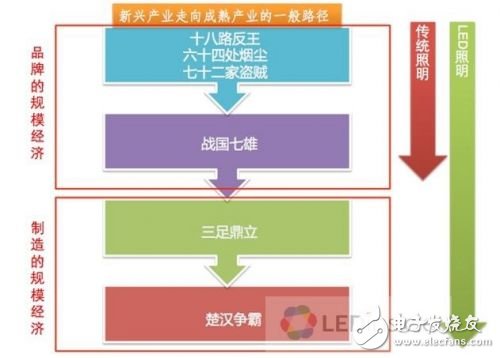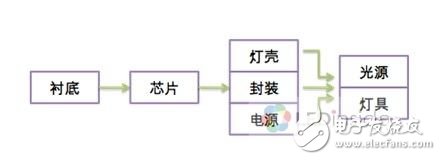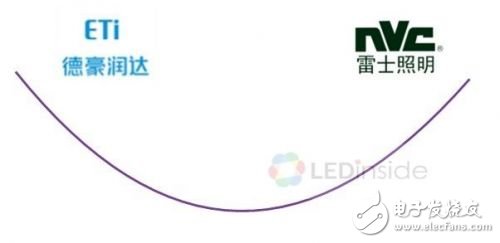At the LEDinside Shanghai Analysis Conference, I finished talking about China's future LED lighting industry. It is likely that the "EMS" is an oligarchic pattern. Then many people asked why it is not the current lighting brand. Then why is Mulinsen, why is the "X" strategy?
Why is it an oligarch?
First of all, I want to go back to a point, why is it an oligarchic pattern? Even though the traditional lighting industry has matured to a stage where it has matured, the market has shown a pattern of several major brands. However, overall, the concentration is still very low, and it still fails to enter the oligarch stage. It can only be said that each brand has its own Relatively dominant market:

One of the limitations is that the traditional lighting industry is not economically significant in terms of manufacturing. After a certain scale, the marginal cost of production will not drop significantly, and the scale of management is not economically obvious. According to my observation, this border is between 150 and 500 million RMB. The output value of more than 500 million yuan can still have a marginal cost reduction, even if it is a method-based lighting manufacturing enterprise. Including international brands such as Philips and OSRAM, if you look at their foundry chain, some factories in Eastern Europe and Southern Europe are for near-production, but even in Asian foundries, they are quite scattered, more than three scales. It is not entirely a consideration of supply chain security, and it is largely uneconomical from the production of traditional lighting products.

Why can the above-mentioned enterprises achieve a scale of 2 to 4 billion? I think that the main source of economies of scale is not just from manufacturing, but from economies of scale in brands and channels. Sufficient sales can eliminate the indiscriminate and highly specialized brand building and channel construction costs. . NVC quickly set off, many people do not understand, the manufacture of NVC is heavily dependent on the foundry, why can it be so fast. This is Wu Changjiang's excellency. I lost a lot of money on advertisements and channels. After the sales volume is washed up, I look back. In fact, there is not much advertising cost for each item amortization. If Wu Changjiang insisted on manufacturing thinking at the beginning, I am afraid that today, NVC is just a lighting shop with green signs hanging on a former shop and a factory in Zhongshan Guzhen.
Looking at the manufacturing industry in the era of LED lighting, from the perspective of the entire industrial chain, upstream crystal growth, compound semiconductor growth, and component packaging are all dependent on high R&D investment and high fixed asset investment. The characteristics of such industries are scale. The economic benefits are very obvious. In theory, they are all economies of scale. Look at the semiconductor industry, the scale is almost equal to competitiveness, usually only the industry first to make money, the second is only barely making money, to the third and fourth are always waiting for the fate of consolidation. The lighting manufacturing industry in the era of LED lighting is inevitably semiconductorized. If automation is introduced in the light source and luminaire manufacturing, the future competitiveness will be more dependent on the scale of production. Under the dual-scale economic effects of brand and manufacturing, the industrial structure dominated by large enterprises will soon become oligopolistic.

Why is EMS?
Let me first talk about why ETI (Dehao Runda), why is the "U" strategy?
At the beginning, when Dehao Runda did not know how to cut into the LED field, the capital market was blindly enthusiastic, and when it was enough to pay for tuition and want to really do something, the market still believed that Wang Donglei was flickering. It's like a child saying that he wants to lick his own glass, a bunch of people come over and watch the stone slingshot. Watching the child knock out his own glass and scream it.
When the last onlookers and the child found that there was only a glass of slag left after the excitement, they all panicked. The child also found himself wrong when he tried to sweep away the glass scum from the window, but it was no longer able to erase the impression of a bad boy. For Dehao Runda, I believe that the initial thoughts of an industry predecessor mean that the LED chip project can be done well. It depends on the original intention. If it is really for the cause, then the government subsidy is the icing on the cake. If it is for subsidies, then the subsidy is the tempting but not full of fat in the trap. As for the initial heart of Chairman Wang, this world is probably only known to him, and only he can prove it to the world. As a bystander and witness to the industry's changes, we are expecting to tell a successful cross-border case of success in many years, rather than a blind transformation investment failure.

Of course, the above episode will not be the reason why ETI is enough to become an oligarchy. ETI's advantage lies in the inclusion of NVC's best offline entry into the entire Dehao system, forming the ETI-NVC combination. Dehao widened the downstream self-rescue action, which was in line with Wu Changjiang’s re-entry into NVC’s vision. I can think of this chess game and implement it quickly. I am afraid that only Wang Donglei’s letter to the bones’ smile curve makes him more than a crowd. The people are more aware of the value of the three letters of NVC, and the low valuation of Hong Kong stocks and the guilt of NVC provide an excellent opportunity. The combination of smile curves is the “U†strategy of Dehao.
Why is this combination amazing? This is to be understood from the benefits of vertical integration. Intuitively, when the overall situation of China's LED lighting market is undecided in 2013-2015, who can grab market share, who is the future winner. But this involves the distribution of profits between different links in the industry chain and between the current and the future.
In 2013, IKEA quickly rose up in indoor LED replacement lamps, and opened the two giants of Philips and OSRAM to become the highest market share in Europe. It originated from IKEA's initial sales of 400lm@2700K bulbs with zero gross profit. Driven by this promotion, other specifications of LED light sources are also hot. China's LED lighting market must also be a fierce killing in 2014. All the companies in the industrial chain will face the price competition with the upstream and downstream enterprises, but if they want to win, only the upstream and downstream will join hands. Today Don't make money, don't make money tomorrow, make big money the day after tomorrow. With Ma Yun, it is said that today is cruel, tomorrow is more cruel, the day after tomorrow is very beautiful, but most people die tomorrow night, can not see the sun of the day after tomorrow.
The advantage of a vertically integrated company lies in the upstream and downstream for the future, first to make profits, gain market share, and then discuss how to make money in the future. From the high-profile announcement of 1 billion orders by NVC and Dehao Runda at the Beijing New Product Launch Conference, the two companies apparently embarked on a non-return with low profits and strong market grabs.
Lithium Storage Battery,Lithium Ion Battery,Lithium Battery,Electric Car Lithium Battery
Henan Xintaihang Power Source Co.,Ltd , https://www.taihangbattery.com